Editor's note 17/12/2024: SRAM GX Eagle AXS was updated in July 2023. Check out our review of the latest SRAM GX Eagle AXS.
SRAM’s GX Eagle AXS groupset is the brand’s latest addition to the AXS wireless electronic shifting lineup.
Featuring all of the trickle-down tech from the more expensive X01 Eagle AXS and XX1 Eagle AXS groupsets, SRAM hopes people with existing Eagle drivetrains will want to enjoy their impressive shifting performance without the prohibitive (for some, at least) price tags.
SRAM GX Eagle AXS groupset headline figures
- Total weight (including 170mm cranks with 32t chainring, rear derailleur with battery, 126 link chain, 10-52t cassette, and shifter): 1,850g
- Total price (including 170mm cranks with 32t chainring, rear derailleur with battery, 126 link chain, 10-52t cassette, and shifter): £913 / $983 / €1,022
- Upgrade kit price (including derailleur and battery, shifter, charger and chain gap tool): £554 / $600 / €620
SRAM GX Eagle AXS groupset details and specifications
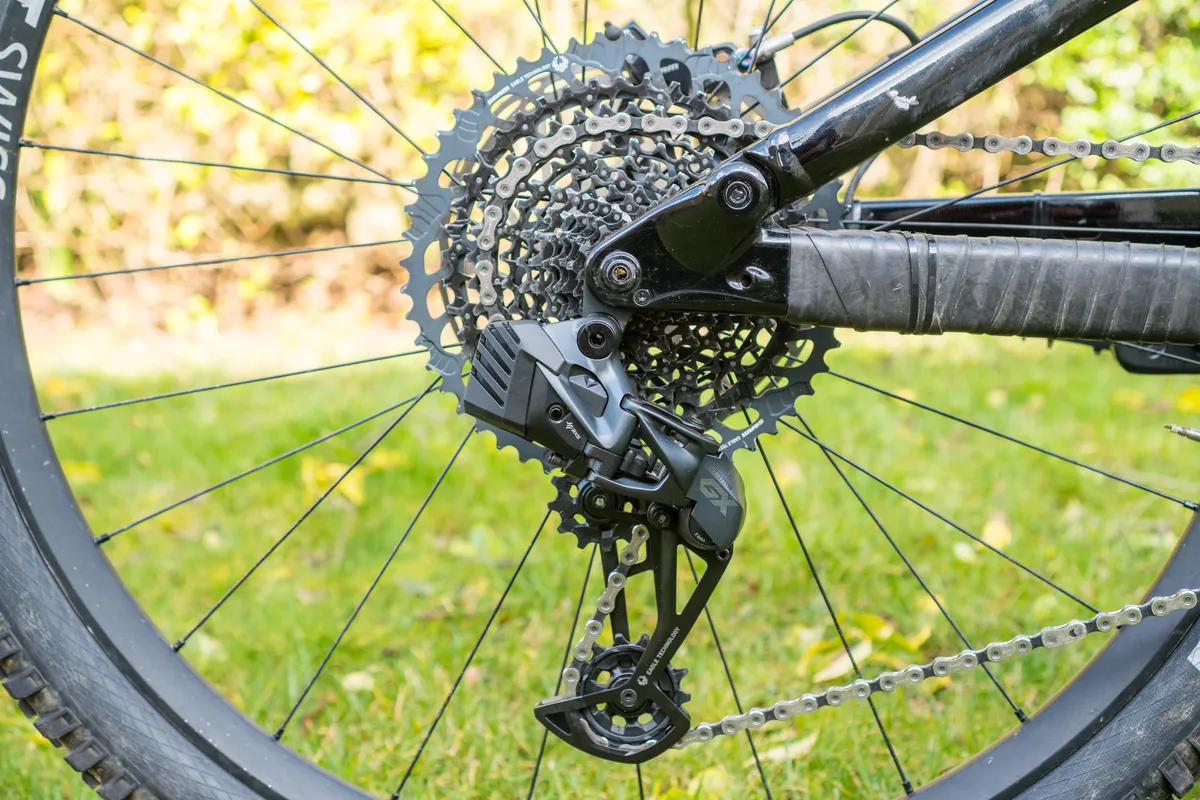
While I have covered a lot of the detail of the newest GX Eagle AXS components in this review, and Rob Weaver has reviewed the 52t GX Eagle mechanical drivetrain, I'll run through some top-line details below.
Because the GX Eagle AXS derailleur and shifter lever is sold as an upgrade kit rather than a full groupset, I have paired it with the rest of the GX Eagle family for the purpose of this testing.
SRAM GX Eagle AXS rear derailleur specifications

The GX Eagle AXS rear derailleur is battery-powered and wirelessly connected to the shifter. SRAM claims the removable and rechargeable onboard battery provides up to 20 hours of riding time on one charge.
It uses SRAM’s Type-3 Roller Bearing Clutch to help mitigate chain slap and improve shifting performance, while it also has a secondary clutch – called the Overload Clutch – that disengages the motor’s gearbox from the derailleur to allow it to pivot out of the way during an impact. The motor then resets the derailleur to its last shift position.
The jockey wheels – the lower of which has a narrow-wide tooth profiling – run on steel cartridge bearings and are fastened to a stamped steel cage. Like all of SRAM’s derailleurs it has its Cage Lock system that removes chain tension to make wheel installation easier.
And like other AXS derailleurs, such as X01 Eagle AXS, it has more cassette chain wrap compared to mechanical Eagle derailleurs. This, SRAM claims, improves chain and cassette life, and increases shifting performance.
My derailleur with battery and battery cover (sold separately for £20 / $20 / €20) weighed 465g.
SRAM GX Eagle AXS controller/shifter lever specifications
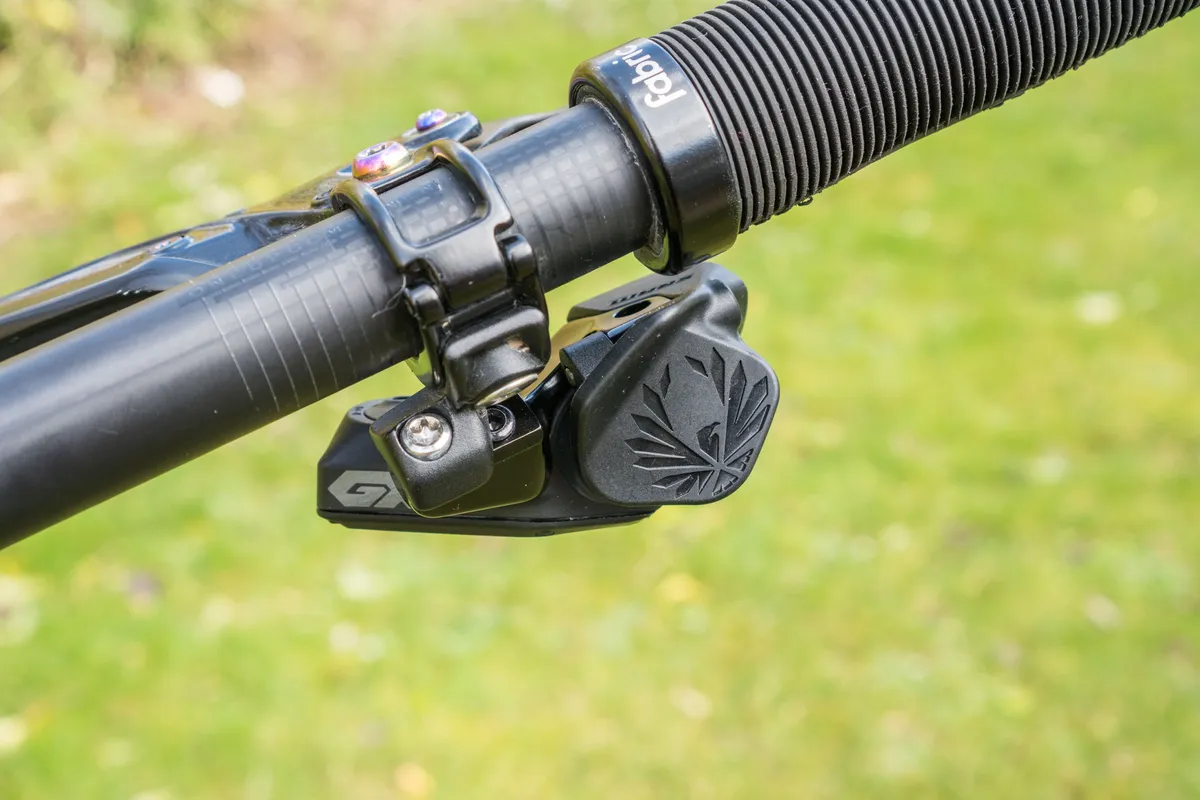
The GX Eagle AXS controller connects wirelessly to the rear derailleur over SRAM’s proprietary encrypted wireless network and needs to be paired to a derailleur using the onboard AXS button.
The shifter has two buttons that can be user-programmed via the AXS smartphone app to function as low or high gear shifters and operated by a rider’s thumb, or a third rear trigger connected to the upper button can be used with the rider’s index finger.
A Rocker Paddle upgrade is available, but all GX Eagle AXS controllers are shipped with the original shift levers.
It uses a CR2032 coin cell battery that’s claimed to provide up to two years of battery life.
My test shifter including bar clamp and battery weighed 80g.
SRAM GX Eagle AXS crankset with 32t chainring specifications

Although GX Eagle is now offered with a carbon crankset, I’ve been testing the aluminium version that’s claimed to be SRAM’s “best aluminium crankset”. It uses SRAM’s DUB axle and bottom bracket technology that’s claimed to improve stiffness and durability.
The driveside crank arm tightens to the non-driveside crank and axle using an 8mm Allen-headed bolt, but additional preload is created by turning a lockring on the non-driveside crank.
Attached to the cranks using three T25 Torx screws is SRAM’s X-SYNC 2 chainring, which uses narrow-wide teeth profiling to ‘grip’ the chain and stop it from derailing off the ring.
My 170mm GX Eagle crankset with 32t chainring weighed 687g on my scales.
SRAM GX Eagle cassette and SRAM GX Eagle chain specifications

Unsurprisingly, the 12-speed 10-52t cassette uses SRAM’s XD Driver standard that differs from the original Shimano HyperGlide (HG) system and Shimano’s new Micro Spline system.
The cassette has stamped steel cogs and 11 of those cogs are held together using 123 pins. The final 10t sprocket is separate and clamped into place using the lockring ring. The GX Eagle cassette has the following ratios of 10t, 12t, 14t, 16t, 18t, 21t, 24t, 28t, 32t, 36t, 42t and 52t.
My GX Eagle 10-52t cassette weighed 455g.
The GX Eagle chain uses solid pins to join each of the links together but shares the same Eagle PowerLock as other SRAM chains for quick and easy chain joining. However, the PowerLock can only be used once.
Flowlink technology features, where the chain’s inner plates are smooth which, SRAM claims, means the chain engages the cassette and chainring with less friction for quiet performance.
An additional benefit means the chain can withstand large angles, which is good for 1x systems with extreme chain lines in the lowest and highest gears.
My GX Eagle 126 link chain with PowerLock weighed 272g.
SRAM GX Eagle AXS groupset compatibility details
The new GX Eagle AXS derailleur and shifter are compatible with any other, current SRAM Eagle chains, chainrings, cassettes and cranks.
The GX Eagle AXS derailleur and shifter are also inter-compatible with X01 Eagle AXS and XX1 Eagle AXS derailleurs and shifters, and will also work with drop-bar SRAM RED or Force eTAP AXS shifters.
SRAM does not recommend using third-party components (such as chainrings, cassettes and chains) with its Eagle drivetrains, however, we know that third-party offerings should work with Eagle kit if the manufacturer states compatibility.
The XD Driver cassette standard might mean a freehub body change if you have an HG design and want to access a 10-50t or 10-52t cassette. SRAM’s NX-level cassette uses the HG system but has an 11-50t ratio. GX Eagle AXS is compatible with NX.
SRAM GX Eagle AXS groupset installation and set up
Pairing the GX Eagle AXS derailleur and shifter was easy, and SRAM’s instructions are clear to follow. Equally, connecting them to the AXS smartphone app was just as simple and even comes with in-built instructions.
To avoid third parties hijacking your AXS equipment, the physical AXS buttons on the derailleur and shifter need to be pressed for pairing to be successful.
Installing the derailleur and shifter was fantastically easy, too. Not having to internally route gear cables or even consider attaching them to the bike feels liberating and is one SRAM AXS's biggest draws. The removal of clutter also helps to improve the bike’s lines.

The SRAM Matchmaker system makes positioning the AXS Controller/shifter lever easy and, like the rest of SRAM’s components, it has two horizontal mounting positions.
The supplied bar clamp is narrow and can further increase the number of potential mounting positions if the Matchmaker system’s options aren’t broad enough.
Installing the cranks was simple, but care needs to be taken to make sure the correct number of spacers is used behind the bottom bracket cups and crank axle for your bike and chain line.
The cassette lockring teeth can be fragile if used with an HG cassette lockring tool with chamfered teeth edges. The chamfering can cause the teeth to round out if the tool isn’t carefully installed, especially when high levels of force are required to remove a stuck-on cassette.
To avoid this issue, first, make sure the freehub driver body and cassette are well-greased and torqued to the specified amount when they are installed.
Second, make sure your cassette lockring tool doesn’t have chamfered edges. The XX1 cassette and NX-level cassette have different lockring engagement teeth and do not suffer as badly from this problem.

I found that SRAM’s recommended chain length instructions for full suspension bikes, where you need to compress or extend the bike’s suspension so the rear axle is as far away from the bottom bracket as possible before sizing the chain, isn’t particularly clear or easy to execute.
Setting the rear axle so it’s as far away from the bottom bracket as possible isn’t as simple as it sounds and requires careful measurement.
Although it’s most likely to be at bottom-out on most bikes, it is sensible to measure the distance between the axle and bottom bracket throughout its travel to get the most accurate setting for your particular setup.
When set like this, the chain was a little on the long side, ending up floppy in the highest gear after adjusting b-tension correctly, requiring the removal of two additional links. Other bikes may vary, so follow the instructions carefully.
The official instructions to only use the PowerLink once are frustrating, especially at the set up phase if the chain is incorrectly sized. In reality, I’ve never had issues using the PowerLink more than once, but do always carry an unused spare in my pack in case it fails during a ride.
SRAM GX Eagle AXS derailleur set up

Indexing the derailleur is remarkably easy because each shift movement is predefined by the cassette’s spacing.
Micro Adjustment, visible in the AXS app, is also easy to implement and makes trimming or fine-tuning the gears a simple process.

The high and low limit screws are also simple to adjust and set and use a 3mm Allen key bolt, so there’s little chance they will get damaged.
Like the rest of SRAM’s Eagle kit, setting b-tension correctly is the most crucial step to getting the best performing gears.
Setting the bike to sag and using the new b-tension gap tool is easier than the old tool – the tool’s ‘bullseye’ indicator needs to line up with the centre of the upper jockey wheel bolt – but it’s an involved process that is more complex than Shimano’s system, which uses a marker on the derailleur cage.

The sensitivity of incorrect b-tension setup is high, which compounds this issue. A badly adjusted setup results in lazy, noisy and clunky shifting, but once it is set up correctly, performance is impressive.
SRAM GX Eagle AXS groupset performance
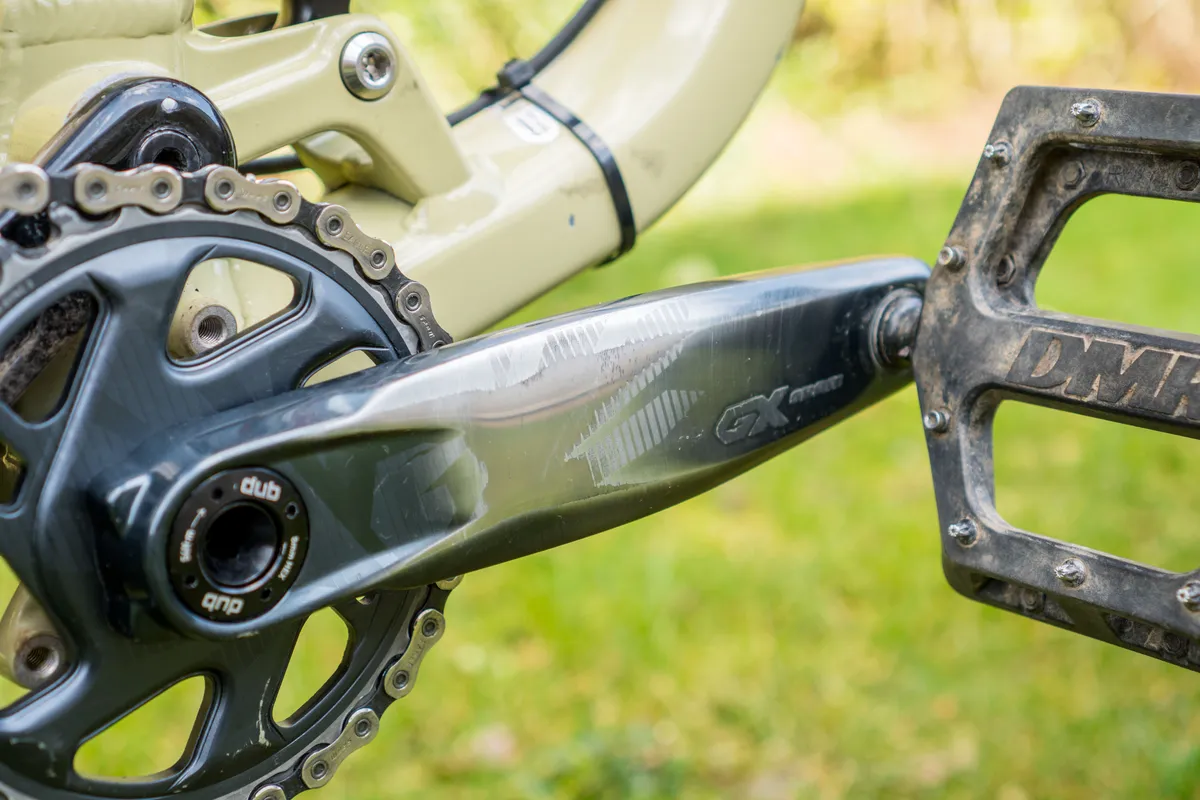
I took to my local trails in the Tweed Valley in Scotland to put SRAM’s brand-new GX Eagle AXS derailleur and GX AXS controller/shifter lever through their paces.
Trail conditions ranged from chunky, rocky chunder to loamy wigglers with plenty of dust, mud, ice and some snow thrown in for good measure.
The GX Eagle AXS components were tested back to back with a host of other mountain bike drivetrains including SRAM’s NX Eagle, GX Eagle mechanical, XX1 Eagle AXS and Shimano’s Deore, SLX, XT and XTR along with some setups from smaller brands.
Needless to say, it received a thorough workout. Below are my thoughts and ride impressions.
SRAM GX Eagle AXS rear derailleur performance
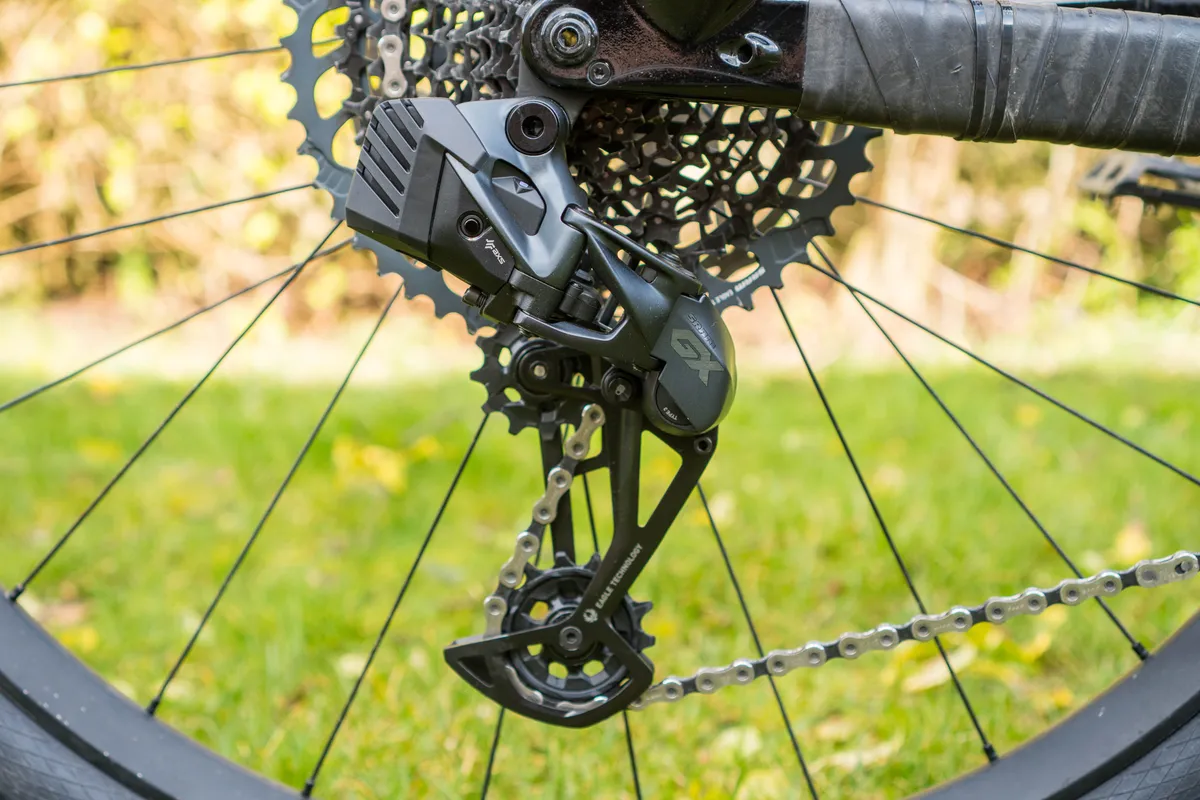
Blindfolded, it would be impossible to distinguish the performance of GX Eagle AXS, X01 Eagle AXS and XX1 Eagle AXS derailleurs. Its shifts were instantaneous, consistent and predictable, where a push of the controller’s button always equated to the derailleur moving the precise amount required for a shift.
Shifting under power was also impressive and, because there is no physical connection between the shift lever and derailleur, it’s impossible to tell whether any additional force is required for the derailleur to shift.
Its shift speed also doesn’t slow down or the motor sound overloaded when shifting unsympathetically up or down the cassette block. Testimony to its power, there were no noises or undue crunches when hammering through the gears.
And clutch tension didn’t interfere with shifts either, the derailleur shifting on cue every time. There was also no perceptible lag between pressing the button and a shift – each shift was arguably quicker than a mechanical system.
Chain control was also impressive. The derailleur held it in the selected gear when freewheeling over rough terrain and also prevented skipping when pedalling in high gears. There was a small amount of chain slap – potentially a fraction more than other systems – hinting that the clutch could have increased tension.

Because its tension can’t interfere with shift lever feel and the motor seems to be strong enough to overcome any resistance during shifts, maybe increasing its tension would further reduce chain slap.
Unfortunately, the clutch isn’t user-adjustable, so we’ll have to wait and see whether SRAM produces a Type-3.1 or Type-4 clutch with more power.
There were sporadic delays in shifting at low cadences where a half or full revolution of the cranks occurred before the next gear was engaged. This didn’t appear to be any fault of the derailleur, more a game of chance if the shift happened just after the cassette’s shifting ramps had passed by the derailleur.
Further revolutions of the cassette were required before the next ramps went by the jockey wheel, permitting a change in cogs. This problem also happened on mechanical NX Eagle, GX Eagle and XX1 Eagle AXS, but is nothing to do with the derailleur.

It also appeared to be impressively robust, taking plenty of knocks and bashes in its stride.
I’d speculate that because the GX Eagle AXS derailleur’s cage is stamped steel it may well be stronger and more resilient than the X01 AXS’s aluminium cage and XX1 AXS’s carbon version.
Battery life appeared to be on par with SRAM’s claims of roughly 20 hours. Battery removal was easy and charging didn’t take long. Because we all use plenty of electronic devices on our rides these days – phones, GPS, GoPros, etc – adding one additional battery into the mix shouldn’t be problematic. But if you are concerned, spares are available, and carrying a second 25g battery in your pack shouldn’t be onerous.
Overall, the derailleur was virtually faultless. SRAM has done a magnificent job of making the impeccable performance of its top-tier AXS kit that little bit more affordable.
SRAM GX Eagle AXS controller/shifter lever performance

Despite initially struggling to get used to the controller’s button layout, regardless of how I set them up to shift, I ended up reverting to and positively appreciating SRAM’s stock settings – where the top, smaller button changes to a higher gear and the lower larger button changes to a lower gear. This is essentially ‘backwards’ compared to traditional mechanical shifters.
The shape and position of the paddles grew on me, too, and I never felt like I needed to stretch my thumb to reach either of the shifters, helped by the lack of physical travel.

My preference for the AXS controller's stock setup only became truly apparent when I switched back to mechanical shifting gears and it took me 30 minutes or so to re-learn how the shifter levers worked.
Both of the buttons' clicks are positive and reasonably well defined, but despite being sprung with a small amount of resistance, they feel like buttons rather than traditional shift levers. Although this makes them light to operate, it also meant that on rough terrain I frequently changed more gears than I wanted to, which was frustrating.
I also preferred the single-shift setup. It is possible to program the shifter to move one, two, three or even all the gears with a prolonged push. To reduce the chances of erroneous shifting, I programmed it to shift one single gear at a time.
Clearly, there was no shift degradation over time. SRAM claims up to two years of battery life for the AXS controller, so check back in two years’ time to find out whether its claims stand up!
SRAM GX Eagle cassette and SRAM GX Eagle chain performance

The chain and cassette ran smoothly together and produced little to no noise when correctly lubricated. Shifts were generally sweet and the steps between gears smooth. On-power shifts felt good, too, and there were no crunching sounds or jumps, notwithstanding the missed ramp shift issue I mentioned before.
Performance seemed consistent even when the chain and cassette were covered in dirt and grime, although a truly clean and well-lubricated drivetrain offered the best performance.
Although the cassette’s sprockets showed signs of cosmetic wear quickly after just two rides – there were scratch marks on their outward-facing surfaces where the chain has been pulled over the shift ramps – their teeth remained hook- and damage-free for the duration of the test period.

The cassette resisted rust well, but the chain, unless dried meticulously, rusted quite quickly. It did always clean up well, though.
As I’ve mentioned in other reviews, the jump from the 42t to 52t cassette sprockets feels quite large compared to the rest of the cassette’s changes in ratio. Although this makes it a true bail-out gear, I found myself stretching out the 42t cog for longer than I liked so I didn’t have to either increase cadence or slow to a crawl.
This was especially pronounced with a 32t chainring, and I certainly preferred SRAM’s Eagle 10-52t cassette with a 30t chainring which helped to make the 42t more usable.

Arguably, SRAM could do with changing the 42t sprocket to a 44t, 45t or 46t to help bridge the gap up to the 52t cog.
SRAM GX Eagle crankset with 32t chainring performance

Although I tend to rub the paintwork and finish off the non-driveside chainstay and crankset quickly, the GX Eagle crankset’s colour started to rub off during the first ride. Considering the finish looks good when new, it’s a shame it deteriorated so quickly.
Despite the finish being weak, the cranks stood up to rock strikes and bashes well, not bending or getting severely damaged.
However, the chainring’s finish appeared to be more robust and because the teeth aren’t coloured it’s impossible to tell when the finish is starting to rub off. They also remained hook- and damage-free during the test period.

It would be remiss of me to not mention the DUB preload ring on the non-driveside crank that’s used to fine-tune bottom bracket bearing load.
Although it’s a great idea and can adjust crank tension for slight tolerance variations, because the lockring is plastic and the small, flimsy 2mm pinch bolt is flimsy, the lockring can undo when torqued up correctly, resulting in loose cranks.
A solution to this problem would be to use a metal lockring that could be tightened and clamped in place much more easily.
SRAM GX Eagle AXS derailleur and controller/shifter lever vs SRAM GX mechanical and Shimano XT drivetrains
From a cost perspective, GX Eagle AXS is expensive. The derailleur retails for £342 / $370 / €385 and the AXS controller/shifter lever is £139 / $150 / €155.
As an upgrade package, the cost is £554 / $600 / €620. For that price, you could buy a whole GX Eagle mechanical groupset and cranks for £495 / $545 / €555. You can also get a full XT M8100 groupset for just a pinch more at £566.94.
However, this feels a bit like comparing apples and oranges because the GX Eagle AXS kit isn’t sold as a complete set – officially at least, but there’s nothing stopping you from buying the rest of the GX line-up to complete it. The only other true wireless electronic drivetrain comparisons are SRAM’s own X01 Eagle AXS (£739 upgrade kit) and XX1 Eagle AXS (£975 upgrade kit), and GX is significantly cheaper than either of those without any discernible drop in performance.
Because it’s being marketed as an upgrade kit rather than a full group, justifying the upgrade expense might be easier if you’re going to be pairing the AXS derailleur and shifter with existing cranks, chainrings, chains and cassettes.
If you do decide to buy a GX Eagle AXS groupset, it’ll set you back £913, but X01 Eagle AXS costs £1,482 and XX1 Eagle AXS is £1,958, so it’s better value for virtually identical performance.
Weight-wise, the GX Eagle AXS derailleur and shifter tip the scales at 545g. The same setup in GX Eagle mechanical level weighs 434g, while Shimano’s XT M8100 is a svelte 418g. For comparison, the same XX1 Eagle AXS components weigh 459g, while mechanical Shimano XTR M9100 parts weigh 373g.
Unless you’re truly concerned about weight over outright shifting performance, and you’re in the market for wireless electronic shifting, I’d be hard-pressed to not recommend GX Eagle AXS as a suitable price and weight compromise, while offering impressive performance.
Compared to Shimano’s XT M8100, GX Eagle AXS feels better when on the bike because of the physical decoupling between shifter and derailleur. XT M8100 comes pretty darn close, though, and the instant, crisp and light feeling shifts are about as good as a mechanical system can get.
GX Eagle AXS won’t degrade over time because there are no bothersome cables to change or route in the first place, either. That’s a big win for me.
Compared to its mechanical GX Eagle stablemate, GX Eagle AXS is a significant step up in shifting performance. Although GX Eagle feels good, it just isn’t as crisp and instant as the AXS version and will degrade over time like any cable-operated system.
I’d happily commit to saying it’s worth the extra cash over mechanical GX Eagle.
SRAM GX Eagle AXS groupset bottom line
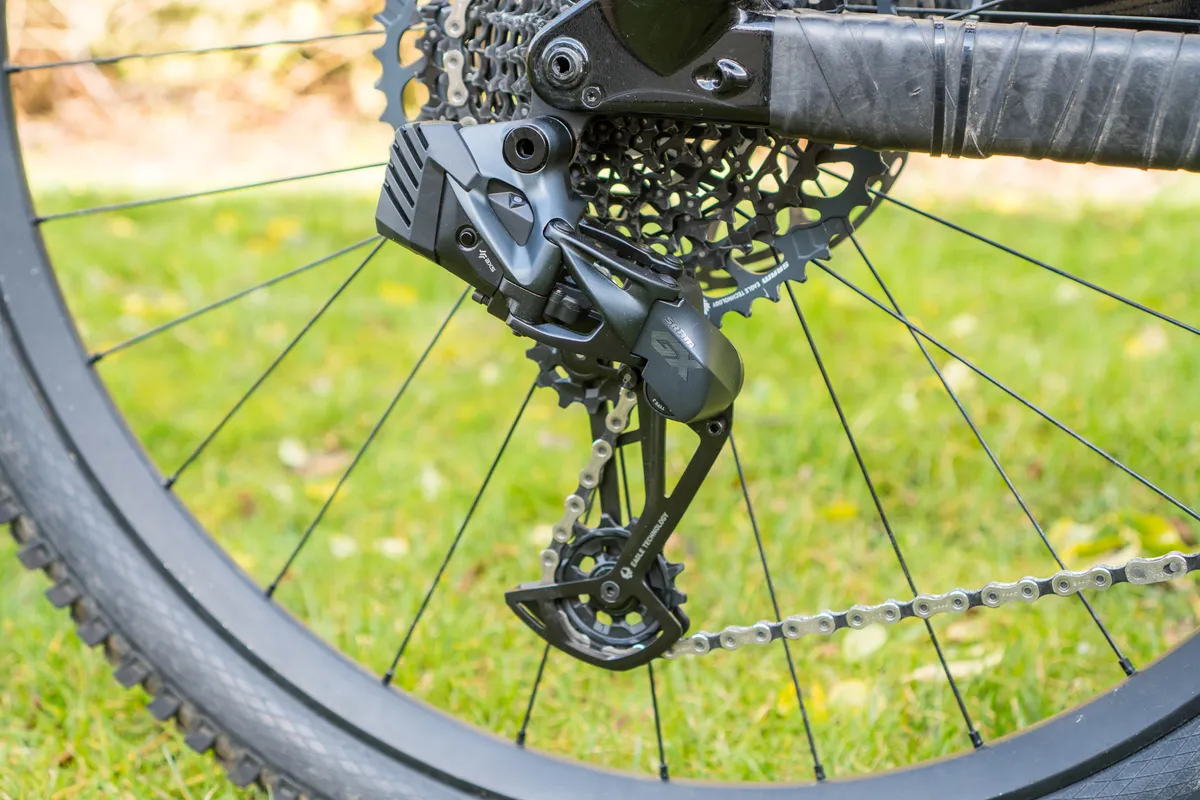
For me, it boils down to performance, and GX Eagle AXS beats every mechanical derailleur and shifter I’ve tried in recent years thanks to performance akin to its X01 and XX1 AXS stablemates, but without the significant costs.
That’s not to say it isn’t expensive, but if you’re in the market for an electronic, wireless drivetrain setup, GX Eagle AXS is hard to argue against.
Product
| Brand | Sram |
| Price | A$904.00, €620.00, £554.00, $600.00 |
| Weight | 1881g |
| br_whatWeTested | SRAM GX Eagle AXS |
Features
| Crank options | 1x |
| Speed | 12 |
| Features | AXS wireless electronic shifting. Derailleur GX Eagle AXS with battery and battery cover: 465g. Shifter GX Eagle AXS (with band clamp and battery): 78g. Cassette GX Eagle AXS: 455g. Chain GX Eagle AXS (126link): 272g. Chainring GX Eagle AXS (32t): 80g. Cranks (170 w/o chainring): 529g. Total: 1,850g. |
| Cassette options | 10-52t |
| Chainring options | 30t, 32t, 34t |
